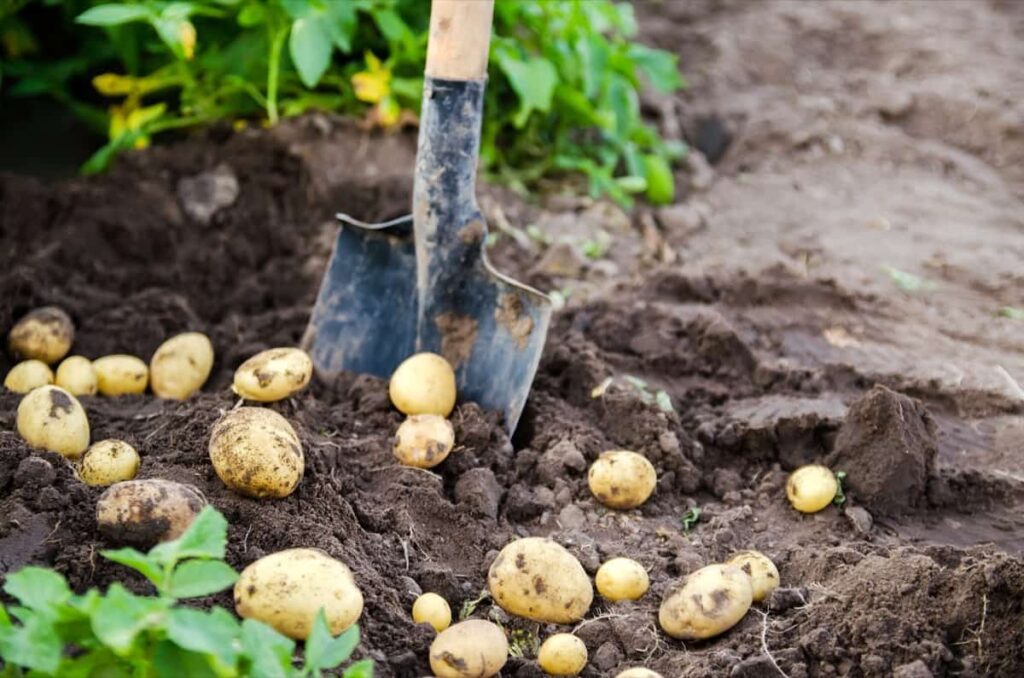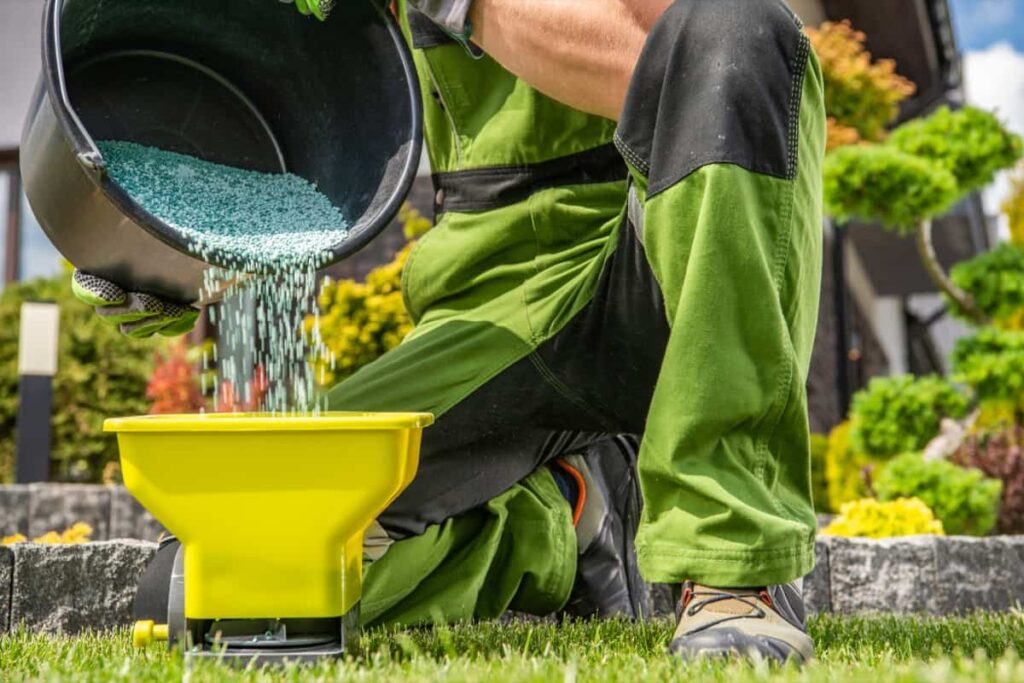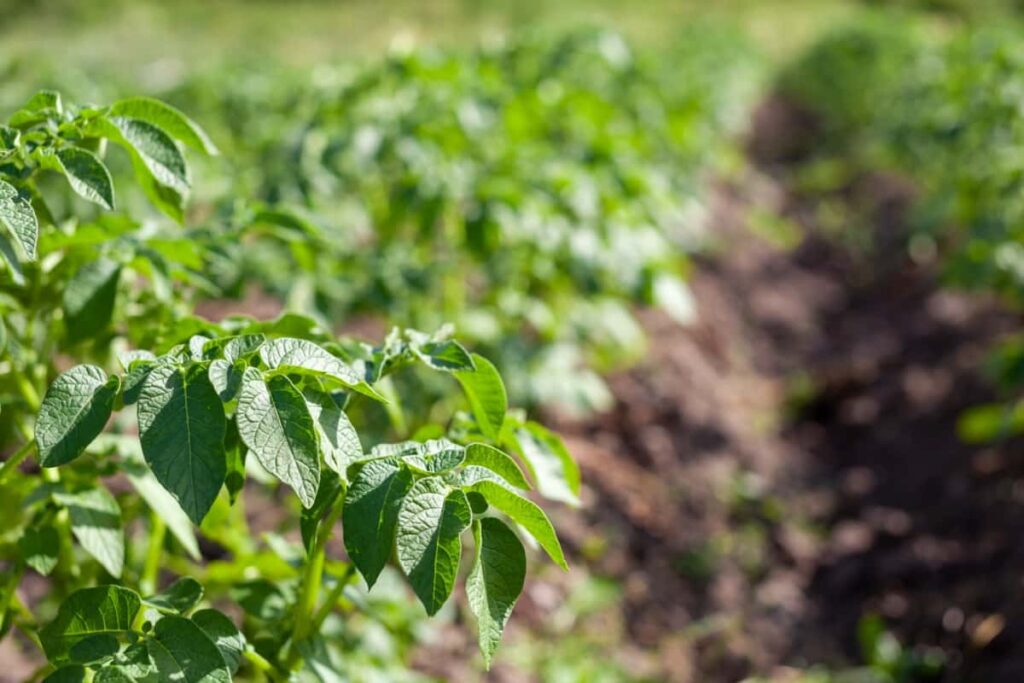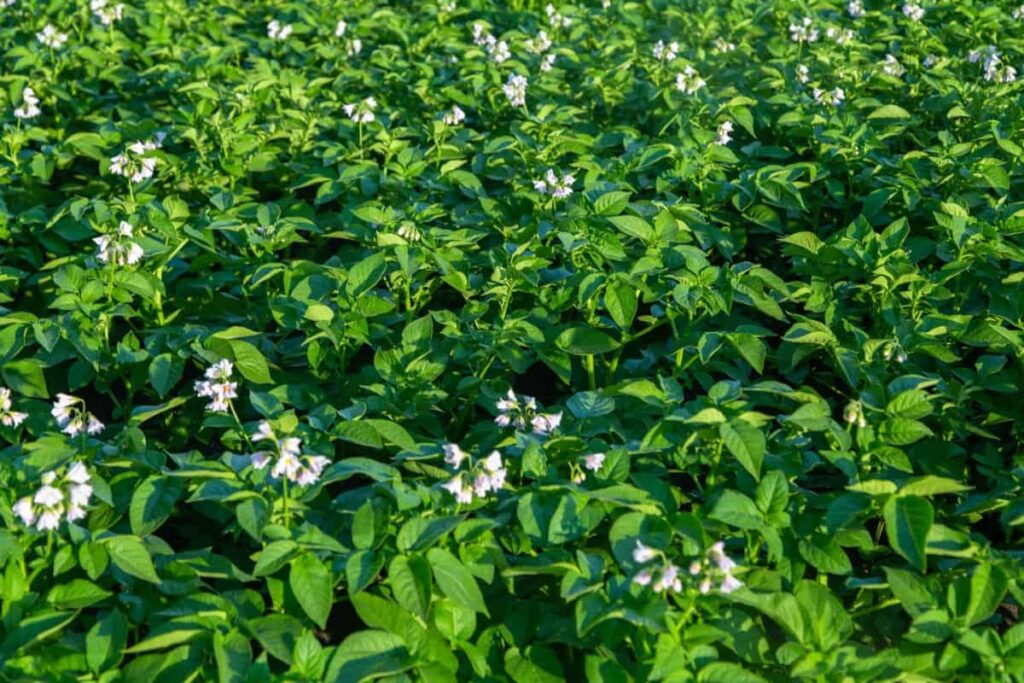Potatoes, a staple crop and beloved vegetable have nourished our plates for centuries. But have you ever wondered how to unlock their full potential? The secret lies in understanding the optimal fertilizer requirements for these versatile tubers. In this blog, we will delve into the depths of potato fertilization, demystifying its science and providing practical insights to help your potato crops thrive.

Fertilizer Requirements for Potato
Description of Potato Cultivation
Potatoes, scientifically known as Solanum tuberosum, are starchy root vegetables originating in the Americas. They belong to the nightshade family Solanaceae and are native to regions extending from the southern United States to southern Chile. The domestication of potatoes by Native Americans was initially believed to have occurred independently in multiple locations.
Potato plants are herbaceous perennials that grow up to 60 cm (24 in) tall and bear flowers in various colors. Insects primarily cross-pollinate them, but self-fertilization can also occur. The tubers, the edible part of the plant, form in response to decreasing day length. Although the fruits of potato plants resemble green cherry tomatoes, they are toxic and unsuitable for consumption due to the presence of solanine.
Best Fertilizer for Potato Growth
Organic and synthetic fertilizers are both effective choices. Some popular natural fertilizers include compost, aged manure, and seaweed extracts. Brands like Burpee, Hoss, and Dr. Earth offer excellent potato products if you prefer packaged organic fertilizers. Synthetic fertilizers, such as all-in-one veggie fertilizers, are commonly used in conventional gardens and farms to promote potato growth. Preparing the soil before planting the seed potatoes is best for feeding your potato plants.
This involves incorporating a slow-release plant food or organic matter like compost into the soil about one to two weeks before planting. In alkaline soils, adding a small amount of sulfur can help lower the pH to create slightly acidic conditions, which potatoes prefer. Once your potato plants start sprouting, you can nourish them. Calcium-rich fertilizers are beneficial at this stage to counteract rust spots. Avoid using synthetic fertilizers containing only nitrogen, phosphorus, and potassium.
Potato Fertilizer Recommendations
The best fertilizers for potatoes include Urea Fertilizer, Jobe’s Organics 09526 Organic All Purpose Granular Fertilizer, and Espoma Garden Food. These fertilizers have proven effective in promoting potato growth and increasing yield. They have a balanced NPK ratio, with relatively low Nitrogen (N) content and higher levels of Phosphorous (P) and Potash (K). An ideal fertilizer ratio for potatoes is 5-10-10. This ratio ensures optimal nutrient balance for the initial two months of potato growth, leading to healthy and productive plants.
In case you missed it: How to Grow Potato Plants Faster: Best Tips to Increase Flowering, Fruiting, and Yield

Organic Fertilizer for Potatoes
It is important to use fertilizer with higher potassium and phosphorus levels than nitrogen for optimal potato growth. A suitable ratio for potato fertilizer would have the second and third numbers up to twice the size of the first Excessive nitrogen promotes foliage growth. Still, as a root vegetable, potatoes require potassium and phosphorus for tuber development. Additional ingredients like cottonseed meal, bone meal, sulfate, and kelp can be mixed to create a beneficial potato fertilizer. Applying a balanced all-purpose slow-release organic fertilizer about a week before planting the seed potatoes is recommended.
NPK Ratio for Potato Fertilizer
When planting potatoes, the ideal NPK ratio is 15-15-15. To encourage the growth of the potato plant at this early stage of life, an NPK ratio of 34-0-0 is recommended. To promote the growth of its roots and tubers after roughly two months, it’s important to modify the NPK ratio and apply a fertilizer with more potassium.
Essential Nutrients for Potato Plants
Like many other plants, potato plants require essential nutrients for their development and growth. The three primary macronutrients that benefit potatoes are nitrogen (N), phosphorus (P), and potassium (K), collectively known as NPK. These macronutrients are required in higher quantities than micronutrients, which are also important for maintaining plant health and achieving optimal harvest. The recommended dosage of these nutrients varies depending on the plant and its growth phase, including potatoes.
- Nitrogen is vital in different stages of a potato plant’s life. It supports the healthy growth of roots, vines, and leaves during the seedling stage and aids in developing roots, tubers, and vegetables as the plant matures.
- Phosphorus is crucial for potato plants’ root and tuber growth throughout their life cycle. It is particularly important for early growth and maintaining growth and health during potato production.
- Potassium assists potato plants in various growing phases by facilitating the transport of water and nutrients. Potassium becomes increasingly beneficial as the plant matures and starts producing potatoes.
In case you missed it: How to Start Sweet Potato Farming in Asia: A Guide of Cultivation for Beginners

Contribution of Micronutrients to the Health of Potato Plants
- Magnesium supports the transfer of energy during the photosynthesis process, ensuring the distribution of food energy throughout the plant.
- Iron aids photosynthesis and is often needed in flooded or highly alkaline soil conditions. Otherwise, iron may already be present in the soil or produced by the plant independently.
- Calcium helps protect potatoes from disease and strengthens the overall structure of the potato plant. Adequate calcium levels are especially important during extreme temperature conditions.
- Boron supports the plant’s metabolism and energy transport and is often naturally present in the soil without additional supplementation.
- Zinc aids in the metabolism of nitrogen, enabling the efficient distribution of energy throughout the potato plant, thereby enhancing its overall health.
- Manganese supports photosynthesis, nutrient metabolism, and energy transfer in potato plants.
Potato Crop Nutrient Requirements
Potato crops have specific nutrient requirements for optimal growth. The primary macronutrients they need are nitrogen (N), phosphorus (P), and potassium (K). Additionally, they benefit from micronutrients like magnesium, iron, calcium, boron, zinc, and manganese. Providing these nutrients is essential for healthy and productive potato plants.
Nutrient Deficiencies and Their Impact on Potato Growth
- Nitrogen (N) deficiency: Insufficient nitrogen leads to stunted growth, yellowing of leaves, and reduced tuber formation. It affects overall plant vigor and crop yield.
- Phosphorus (P) deficiency: Lack of phosphorus results in slow growth, dark green leaves, and delayed maturity. It negatively affects tuber development and reduces yield.
- Potassium (K) deficiency: Potassium deficiency causes yellowing of leaf margins, weak stems, and poor tuber quality. It can lead to lower yields and increased susceptibility to diseases.
- Magnesium (Mg) deficiency: Insufficient magnesium causes interveinal chlorosis, or yellowing between leaf veins, reducing photosynthesis and lower yields.
- Iron (Fe) deficiency: Iron deficiency leads to the yellowing of younger leaves while veins remain green. It affects chlorophyll production and reduces plant growth.
- Calcium (Ca) deficiency: Calcium deficiency results in distorted leaves, blossom end rot in tubers, and reduced tuber quality.
- Boron (B) deficiency: Boron deficiency causes distorted and cracked tubers, hollow heart, and reduced tuber yield and quality.
- Zinc (Zn) deficiency: Zinc deficiency leads to stunted growth, interveinal chlorosis, and reduced tuber size and yield.
- Manganese (Mn) deficiency causes chlorotic spots and reduced growth and yield.
How to Fertilize Potatoes
To fertilize potato plants effectively, test your soil to determine the specific nutrient requirements. A home soil test or using pre-fertilized potting mix in bags can help with this. Once you know which nutrients are needed, follow the manufacturer’s instructions for granular fertilizer application or mix liquid fertilizer with water for watering.
In case you missed it: [Best Practices to Grow Sweet Potatoes at Home: Check How this Guide Helps Beginners

Be cautious not to over-fertilize, as it can harm the plants and decrease yields. If you need more fertilizer, applying less than more is better. Proper fertilization is essential for both home and commercial potato cultivation. Carefully read fertilizer labels to choose the right product for your needs, and employ suitable application methods to provide the necessary nutrients for healthy potato plant growth.
Fertilizer Schedule for Potatoes
- Apply fertilizer for potatoes a week or two before planting the tubers to allow for proper breakdown and absorption by the soil.
- Pre-fertilize using a slow-release organic granular fertilizer or pre-fertilized potting mix for potato grow bags.
- Avoid additional fertilizer until the plants have sprouted above the soil.
- Slow-release fertilizers may only require one application, while nutrient-deficient soil may benefit from frequent water-soluble fertilizers throughout the growing season.
- Use liquid organic fertilizer every few weeks to promote strong growth.
- Apply a calcium-rich fertilizer 2-4 weeks after planting to support plant cell development during increased growth.
- Potatoes typically take 3-4 months to grow, so ensure you have an ample supply of your preferred fertilizer.
Potato Fertilizer Application Methods
- Surface application: Sprinkle granular fertilizer on the soil surface around the plants according to the manufacturer’s instructions.
- Incorporation: Work the granular fertilizer into the top 6 inches of soil before planting the potatoes.
- Pre-fertilized potting mix: Using potato grow bags, use pre-fertilized potting mix as a base.
- Watering can or Hose-end applicator: Mix liquid fertilizer with water and apply it to the soil using a watering can or hose-end applicator.
- Slow-release fertilizer: Apply slow-release fertilizer once, several weeks after planting, for gradual nutrient release.
Slow-Release Fertilizer for Potatoes
Slow-release fertilizers benefit potato plants by providing a steady and gradual release of nutrients over time. These fertilizers are typically applied once, several weeks after planting, and deliver nutrients to the plants as needed, promoting sustained growth and healthier potato yields.
Foliar Fertilizer for Potato Plants
Urea Fertilizer, Trace Elements Helatine Potato, and Jobe’s organic all-purpose granular fertilizer are the best potato fertilizers. Potatoes require more nitrogen (N-P-K 34-0-0) during the initial two months of growth for foliage development. From the second month, potassium (12-12-18 or 14-7-22) is needed until two weeks before the growing season ends. Foliar fertilizer can increase yield in the second and third months.
In case you missed it: Growing Tomatoes Organically in Andhra Pradesh: Requirements, Planting to Harvesting Guide for Beginners

Nitrogen is essential for leaf photosynthesis, while phosphorus is crucial for tuber production. Urea Fertilizer with 46% nitrogen content is a top choice for potential production. Jobe’s Organics All Purpose Granular Fertilizer is a natural option for faster results, containing a balanced NPK ratio of 4:4:4. Espoma Garden Food provides high-quality phosphorus for increased tuber growth.
High Potassium Fertilizer for Potatoes
High potassium fertilizer is beneficial for potato plants. It helps improve their growth and yield. Potassium is crucial in various plant processes, such as photosynthesis, water uptake, and nutrient transport. High potassium fertilizer ensures that potatoes receive an adequate supply of this essential nutrient.
Research studies have shown that potassium-rich fertilizers can enhance potato tuber size, quality, and crop production. Additionally, potassium helps potato plants resist diseases and stress conditions. Therefore, incorporating high potassium fertilizer into potato cultivation practices can produce healthier and more productive potato crops.
Nitrogen Requirements for Potato Crops
Potato crops require nitrogen for healthy growth and maximum yield. The amount of nitrogen needed depends on soil fertility, potato variety, and environmental conditions. Adequate nitrogen supply ensures the proper development of leaves, stems, and tubers. Research suggests an average potato crop requires around 100-150 kilograms of nitrogen per hectare.
Phosphorus Deficiency in Potato Plants
Phosphorus deficiency can negatively impact potato plants’ growth and productivity. When potato plants lack sufficient phosphorus, they may exhibit stunted growth, delayed maturity, and reduced tuber formation. Adequate phosphorus supply is crucial for energy transfer, root development, and overall plant metabolism. Studies suggest that potato crops typically require around 60-100 kilograms of phosphorus per hectare.
Calcium Fertilizer for Potatoes
Applying calcium fertilizer to potato crops can benefit plant health and tuber quality. Calcium is vital in strengthening cell walls, reducing the risk of diseases, and preventing common potato disorders like internal rust spots and blackheart. Adequate calcium levels in the soil enhance nutrient uptake and promote robust potato growth.
Potato Fertilization Techniques
Application Metho
It’s best to distribute fertilizer evenly over the soil surface or apply it in rows alongside potato plants. Broadcasting ensures even distribution, while row application requires more effort.
Maximizing Yield
- Test soil for nutrient deficiencies before planting.
- Use balanced fertilizers with equal amounts of nitrogen, phosphorus, and potassium.
- Apply fertilizer at the right time and water plants regularly for proper nutrient uptake.
- Organic fertilizers can enhance soil fertility and reduce environmental impact.
Common Mistakes
- Over-fertilizing, which stunts growth and reduces yield.
- Using inappropriate fertilizer types leads to nutrient imbalances.
- Need for more timely timing or insufficient watering impacts yield.
Organic vs. Synthetic Fertilizers
Organic options are eco-friendly and enhance soil fertility, while synthetic fertilizers offer precise nutrient ratios and easy application. Choose based on gardening goals, soil type, and environmental considerations.
In case you missed it: Mastering the Dragon Fruit Orchard Management: A Month-by-Month Operations Guide for Maximum Yield

Troubleshooting
When encountering issues such as nutrient deficiencies, over-fertilization, or imbalances, conduct regular soil testing, adjust fertilization schedules, and consider alternative fertilizer types.
Sustainable Fertilizers for Potatoes
- Organic Fertilizers: Derived from natural sources like compost, manure, and plant residues, organic fertilizers improve soil health and nutrient availability. They also reduce the risk of groundwater pollution and contribute to sustainable agriculture practices.
- Slow-Release Fertilizers: These types gradually release nutrients over an extended period, ensuring a steady supply for potato plants while minimizing nutrient leaching and runoff.
- Biofertilizers contain beneficial microorganisms that enhance nutrient uptake, improve soil structure, and promote plant growth. Examples include nitrogen-fixing bacteria and mycorrhizal fungi.
- Nutrient Recycling: Recycling agricultural waste or byproducts, such as crop residues or livestock manure, helps close the nutrient loop, reduces waste, and provides sustainable fertilization.
Conclusion
Understanding and implementing optimal fertilizer requirements is crucial for thriving potato crops. By providing the right balance of nutrients, considering soil conditions, and adopting sustainable practices, growers can maximize yields, promote plant health, and ensure long-term success in potato cultivation.
- Aquaponic Farming at Home: A Step-By-Step Guide
- Profitable Village Farming Business Ideas in 2024
- High-Yield Aquaculture: Fast-Growing Fish for Farming
- Effective Fish Pond Construction Techniques for Beginners
- Irrigation and Water Management in Pineapple Farming
- Blossom to Harvest: Mastering Flowering and Pollination in Papaya Farming
- Pig Fattening Essentials: From Selection to Sale for Beginners
- Raising Wagyu Cattle: A Complete Guide for Premium Beef Production
- Soil Types and Their Water Holding Capacity
- Optimizing Irrigation Schedules for Coconut Groves for Enhanced Yield
- Espresso Your Garden: Coffee Grounds for Healthier Acid-Loving Plants
- The Best Soil Mix for Snake Plants: How to Mix Your Own Snake Plant Soil
- Green Thumb Success: Expert Tips for Cultivating Greenhouse Beans All Year Round
- Bloom All Year Round: The Ultimate Guide to Indoor Hyacinth Care
- Eco-Friendly Gardening: How to Make Liquid Fertilizer from Kitchen Waste
- Ultimate Guide to Grow Anise in Pots: Explore Seed Propagation to Harvesting
- Guide to Raising Chester White Pigs: Discover Breed Facts to Growth Management
- Mastering the Elegance: The Ultimate Guide to Weeping Cherry Tree Care, Planting, and Maintenance
- Ultimate Guide to Planting Garlic in Grow Bags: Growing Strategies for Beginners
- How to Fix Spider Plant Leaf-Related Problems: Natural and Organic Remedies
- 10 Reasons Why Your Tulsi Plant is Shedding Leaves: Home Remedies and Solutions
- Optimizing Growth and Yield: The Advantages of Palm Bunch Ash Fertilizer
- Utilizing Neem Oil Extract as a Natural Pesticide for Hydrangea
- From Soil to Harvest: Various Ways in Which Farmers Can Use AI Tools
- Steps to Encourage and Induce Citrus Flowers: A Comprehensive Guide
- How to Fix Snake Plant Leaf-Related Issues: Natural and Organic Remedies
- Transform Your Garden into a Fragrant Oasis with Raat Ki Rani (Night Blooming Jasmine)
- Discover the Ideal Chicken Breeds for Philippine Farms
- How to Create a Poultry Egg Farm Business Plan for Profits
- Grow Lemon Cucumbers Like a Pro: Insider Techniques for Bountiful Yields
- Ultimate Guide to Caring for Your Pink Princess Philodendron: Tips for Thriving Variegation
- Areca Nut Profit Per Acre: Calculating Yield and Cost of Cultivation
- How Kaveri Chicken is Becoming a More Profitable Breed in Indian Backyards
- Transform Your Barn: 9 Steps to Convert a Horse Stall into a Chicken Coop
- Exploring Suffolk Sheep Disadvantages with Limitations and Challenges
- Guide to Solving Potted Lemon Tree Problems: How to Revive Lemon Tree in Containers
